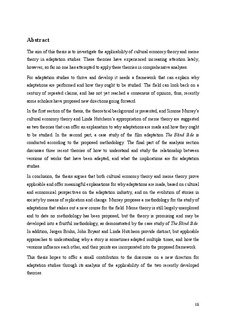| dc.description.abstract | The aim of this thesis is to investigate the applicability of cultural economy theory and meme theory in adaptation studies. These theories have experienced increasing attention lately; however, so far no one has attempted to apply these theories in comprehensive analyses.
For adaptation studies to thrive and develop it needs a framework that can explain why adaptations are performed and how they ought to be studied. The field can look back on a century of repeated claims, and has not yet reached a consensus of opinion; thus, recently some scholars have proposed new directions going forward.
In the first section of the thesis, the theoretical background is presented, and Simone Murray’s cultural economy theory and Linda Hutcheon’s appropriation of meme theory are suggested as two theories that can offer an explanation to why adaptations are made and how they ought to be studied. In the second part, a case study of the film adaptation The Blind Side is conducted according to the proposed methodology. The final part of the analysis section discusses three recent theories of how to understand and study the relationship between versions of works that have been adapted, and what the implications are for adaptation studies.
In conclusion, the thesis argues that both cultural economy theory and meme theory prove applicable and offer meaningful explanations for why adaptations are made, based on cultural and economical perspectives on the adaptation industry, and on the evolution of stories in society by means of replication and change. Murray proposes a methodology for the study of adaptations that stakes out a new course for the field. Meme theory is still largely unexplored and to date no methodology has been proposed, but the theory is promising and may be developed into a fruitful methodology, as demonstrated by the case study of The Blind Side. In addition, Jørgen Bruhn, John Bryant and Linda Hutcheon provide distinct, but applicable approaches to understanding why a story is sometimes adapted multiple times, and how the versions influence each other, and their points are incorporated into the proposed framework.
This thesis hopes to offer a small contribution to the discourse on a new direction for adaptation studies through its analysis of the applicability of the two recently developed theories. | nb_NO |
